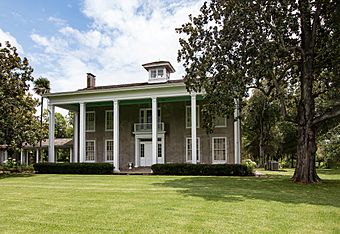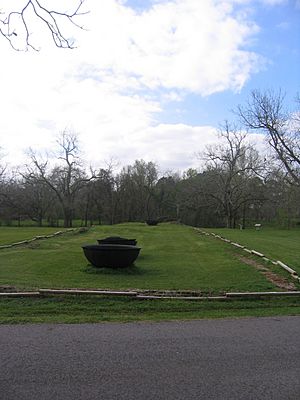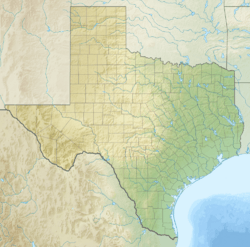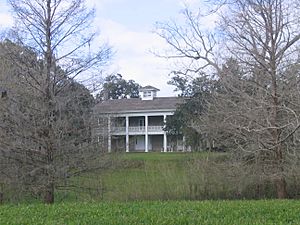Varner–Hogg Plantation State Historic Site facts for kids
|
Varner-Hogg Plantation
|
|

Originally the rear of the house, Ima Hogg converted this to be the front entrance of Varner-Hogg in the 1920s
|
|
| Nearest city | West Columbia, Texas |
|---|---|
| Area | 65.7 acres (26.6 ha) |
| Built | 1824 |
| Architectural style | Greek Revival |
| NRHP reference No. | 80004082 |
Quick facts for kids Significant dates |
|
| Added to NRHP | April 9, 1980 |
The Varner–Hogg Plantation State Historic Site is a special historical place managed by the Texas Historical Commission. It was once the home of James S. Hogg, who was a governor of Texas, and his family. This important site is located near West Columbia, in Brazoria County.
Contents
Exploring the History of Varner-Hogg Plantation
The Varner-Hogg Plantation has a long and interesting past, starting even before Texas became a state. It tells the story of early settlers, farming, and how the land changed over time.
Early Days with Martin Varner
The land was first owned by Martin Varner, one of the "Old Three Hundred" settlers who came to Texas with Stephen F. Austin. Varner received a huge piece of land, more than 4,600 acres, in 1824. He built the first house, a log cabin, that same year. On his land, Varner grew corn, raised cattle, and planted sugar cane. He also had at least two enslaved people working on his property.
The Patton Family and Sugar Farming
In 1834, Varner sold his land to Columbus R. Patton. For many years, the property was known as the Patton Plantation. The Patton family built the main house that stands today, right where Varner's cabin used to be. They turned the property into a large sugar plantation. Columbus Patton brought enslaved people from Kentucky, and by 1833, there were sixty-six enslaved people working on the 13,500 acres of land.
Several members of the Patton family played a part in the Texas Revolution. William H. Patton was a special assistant to Sam Houston, a famous leader. William was even part of the group that guarded Antonio López de Santa Anna after he was captured at the Battle of San Jacinto. Santa Anna was held at the Patton Plantation for a short time.
Changes and Challenges for the Plantation
In 1854, Columbus Patton was declared unable to manage his affairs. His property was then looked after by John Adriance. When Patton passed away in 1856, his estate went through a legal process because he hadn't left a clear will at first. Later, a will from 1853 was found. This will mentioned that some enslaved people should not be hired out and should receive money each year. One of these individuals was Rachel. After some legal discussions, Rachel received her financial support and the freedom to move among properties owned by the Patton family. The Patton family eventually sold the property in 1869.

The plantation was managed using a system where prisoners worked the land until the Galveston Hurricane of 1900. This huge storm destroyed most of the buildings, but the main farmhouse survived.
The Hogg Family's Legacy
Former Governor Jim Hogg bought the property in 1902. He saw it as an investment, believing there was a lot of oil underground. He started drilling soon after buying it. Sadly, he passed away in 1906, 14 years before oil was finally discovered in 1920. This oil discovery became the foundation of his children's wealth.
The Hogg family rented out the land for livestock grazing and farming. Governor Hogg's daughter, Ima Hogg, lovingly restored the house. In 1958, she gave the property to the state of Texas. She wanted it to honor her father and other Texas heroes. During her renovations, Ima Hogg decorated each room to represent a different period in Texas history.
Location and Features of the Site
The Varner-Hogg Plantation State Historic Site is located about two miles north of West Columbia. It covers nearly 66 acres of land. Varner Creek flows through the property, adding to its natural beauty.
The site features an 1835-era farmhouse, beautifully restored by Miss Ima. The house and other buildings help visitors imagine what plantation life in Texas was like before the Civil War. The property was recognized for its historical importance and added to the National Register of Historic Places on April 9, 1980.
See also




